United States Virgin Islands
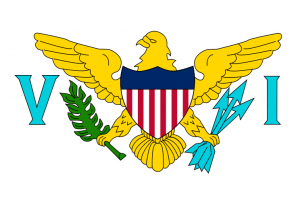
Destination US Virgin Island
The U.S. Virgin Islands is a paradise with so much more to offer than the traditional beach vacation. Visitors wishing to immerse themselves in a profound cultural experience can enjoy historical tours, culinary encounters, artisan fairs, parades, storytelling and other special presentations. Walking tours on St. Thomas and St. Croix feature the diverse architecture, evidence of nations that colonized the islands in the 17th and 18th centuries. Video brought to you by Travelindex Network and Travel & Tourism Foundation. Travelindex.com is the World’s largest Travel Directory. We invite you to submit your tourism, travel or destination site for publication, its free, at http://www.Travelindex.com.
The Virgin Islands of the United States (commonly called the United States Virgin Islands, U.S. Virgin Islands, American Virgin Islands or USVI) are a group of islands in the Caribbean that are an insular area of the United States. The islands are geographically part of the Virgin Islands archipelago and are located in the Leeward Islands of the Lesser Antilles.
The U.S. Virgin Islands consist of the main islands of Saint Croix, Saint John, andSaint Thomas, along with the much smaller but historically distinct Water Island, and many other surrounding minor islands. The total land area of the territory is 133.73 square miles (346.4 km2). The territory’s capital is Charlotte Amalie on the island of Saint Thomas.
As of the 2010 U.S. Census, the population was 106,405, mostly composed by those of Afro-Caribbean descent. Tourism is the primary economic activity, although there is a significant rum manufacturing sector.
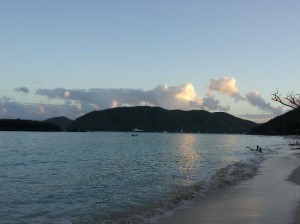 Formerly the Danish West Indies, they were sold to the United States by Denmark in the Treaty of the Danish West Indies of 1916. They are classified by the UN as a Non-Self-Governing Territory, and are currently an organized, unincorporated United States territory. The U.S. Virgin Islands are organized under the 1954 Revised Organic Act of the Virgin Islands and have since held five constitutional conventions. The last and only proposed Constitution, adopted by the Fifth Constitutional Convention in 2009, was rejected by the U.S. Congress in 2010, which urged the convention to reconvene to address the concerns Congress and the Obama administration had with the proposed document. The convention reconvened in October 2012 to address these concerns, but was unable to produce a revised Constitution before its October 31 deadline.
Formerly the Danish West Indies, they were sold to the United States by Denmark in the Treaty of the Danish West Indies of 1916. They are classified by the UN as a Non-Self-Governing Territory, and are currently an organized, unincorporated United States territory. The U.S. Virgin Islands are organized under the 1954 Revised Organic Act of the Virgin Islands and have since held five constitutional conventions. The last and only proposed Constitution, adopted by the Fifth Constitutional Convention in 2009, was rejected by the U.S. Congress in 2010, which urged the convention to reconvene to address the concerns Congress and the Obama administration had with the proposed document. The convention reconvened in October 2012 to address these concerns, but was unable to produce a revised Constitution before its October 31 deadline.
History of the United States Virgin Islands
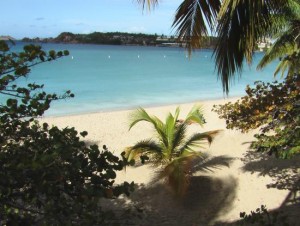 The Virgin Islands were originally inhabited by the Ciboney, Carib, and Arawaks. The islands were named by Christopher Columbus on his second voyage in 1493 for Saint Ursula and her virgin followers. Over the next two hundred years, the islands were held by many European powers, including Spain, Great Britain, the Netherlands, France, and Denmark-Norway.
The Virgin Islands were originally inhabited by the Ciboney, Carib, and Arawaks. The islands were named by Christopher Columbus on his second voyage in 1493 for Saint Ursula and her virgin followers. Over the next two hundred years, the islands were held by many European powers, including Spain, Great Britain, the Netherlands, France, and Denmark-Norway.
The Danish West India Company settled on Saint Thomas in 1672, on Saint John in 1694, and purchased Saint Croix from France in 1733. The islands became royal Danish colonies in 1754, named the Danish-Westindian islands (Danish: De dansk-vestindiske øer). Sugarcane, produced by slave labor, drove the islands’ economy during the 18th and early 19th centuries, until the abolition of slavery by Governor Peter von Scholten on July 3, 1848.
For the remainder of the period of Danish rule, the islands were not economically viable and significant transfers were made from the Danish state budgets to the authorities in the islands. In 1867 a treaty to sell Saint Thomas and Saint John to the United States was agreed, but the sale was never effected. A number of reforms aimed at reviving the islands’ economy were attempted, but none had great success. A second draft treaty to sell the islands to the United States was negotiated in 1902 but was narrowly defeated in the Danish parliament.
The onset of World War I brought the reforms to a close and again left the islands isolated and exposed. During the submarine warfare phases of the First World War, the United States, fearing that the islands might be seized by Germany as a submarine base, again approached Denmark with a view to buying them. After a few months of negotiations, a selling price of $25 million in United States gold coin was agreed (this is equivalent to $580 million in 2013 dollars). At the same time the economics of continued possession weighed heavily on the minds of Danish decision makers, and a consensus in favor of selling emerged in the Danish parliament.
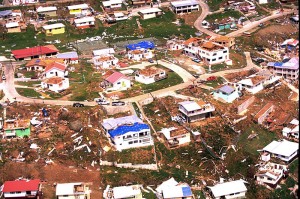 Aftermath of Hurricane Marilyn on the island of St. Thomas, 1995.
Aftermath of Hurricane Marilyn on the island of St. Thomas, 1995.
The Treaty of the Danish West Indies was signed in August 1916, with a Danish referendum held in December 1916 to confirm the decision. The deal was finalized on January 17, 1917, when the United States and Denmark exchanged their respective treaty ratifications. The United States took possession of the islands on March 31, 1917 and the territory was renamed the Virgin Islands of the United States. Every year Transfer Day is recognized as a holiday, to celebrate the acquisition of the islands by the United States. U.S. citizenship was granted to the inhabitants of the islands in 1927.
Water Island, a small island to the south of Saint Thomas, was initially administered by the U.S. federal government and did not become a part of the U.S. Virgin Islands territory until 1996, when 50 acres (200,000 m2) of land was transferred to the territorial government. The remaining 200 acres (81 ha) of the island were purchased from the U.S. Department of the Interior in May 2005 for $10, a transaction which marked the official change in jurisdiction.
Hurricane Hugo struck the Virgin Islands in 1989, causing catastrophic physical and economic damage. The territory was again struck by Hurricane Marilyn in 1995, killing eight people and causing more than $2 billion in damage. The islands were again struck by Hurricane Bertha, Hurricane Georges, Hurricane Lenny and Hurricane Omar in 1996, 1998, 1999 and 2008, respectively, but damage was not as severe in those storms.
Geography of the United States Virgin Islands
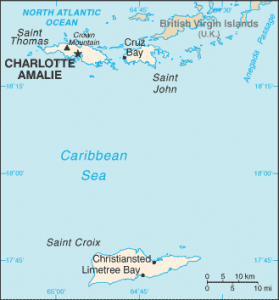 Map of the United States Virgin Islands.
Map of the United States Virgin Islands.
The U.S. Virgin Islands are in the Atlantic Ocean, about 40 miles (64 km) east of Puerto Rico and immediately west of the British Virgin Islands. They share the Virgin Islands Archipelago with the Spanish Virgin Islands (administered by Puerto Rico) and the British Virgin Islands. The territory consists of four main islands: Saint Thomas,Saint John, Saint Croix, and Water Island, as well as several dozen smaller islands. The main islands have nicknames often used by locals: “Twin City” (St. Croix), “Rock City” (St. Thomas) and “Love City” (St. John). The combined land area of the islands is roughly twice the size of Washington, D.C.
The U.S. Virgin Islands are known for their white sand beaches, including Magens Bay and Trunk Bay, and strategic harbors, including Charlotte Amalie and Christiansted. Most of the islands, including Saint Thomas, are volcanic in origin and hilly. The highest point is Crown Mountain, Saint Thomas (1,555 ft or 474 m).
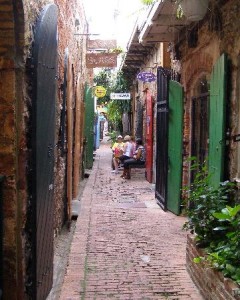 Saint Croix, the largest of the U.S. Virgin Islands, lies to the south and has a flatter terrain. The National Park Service owns more than half of Saint John, nearly all of Hassel Island, and many acres of coral reef. (See also Virgin Islands National Park, Virgin Islands Coral Reef National Monument, Buck Island Reef National Monument, Christiansted National Historic Site, and Salt River Bay National Historical Park and Ecological Preserve).
Saint Croix, the largest of the U.S. Virgin Islands, lies to the south and has a flatter terrain. The National Park Service owns more than half of Saint John, nearly all of Hassel Island, and many acres of coral reef. (See also Virgin Islands National Park, Virgin Islands Coral Reef National Monument, Buck Island Reef National Monument, Christiansted National Historic Site, and Salt River Bay National Historical Park and Ecological Preserve).
The U.S. Virgin Islands lie on the boundary of the North American plate and the Caribbean Plate. Natural hazards include earthquakes and tropical cyclones (including hurricanes).


